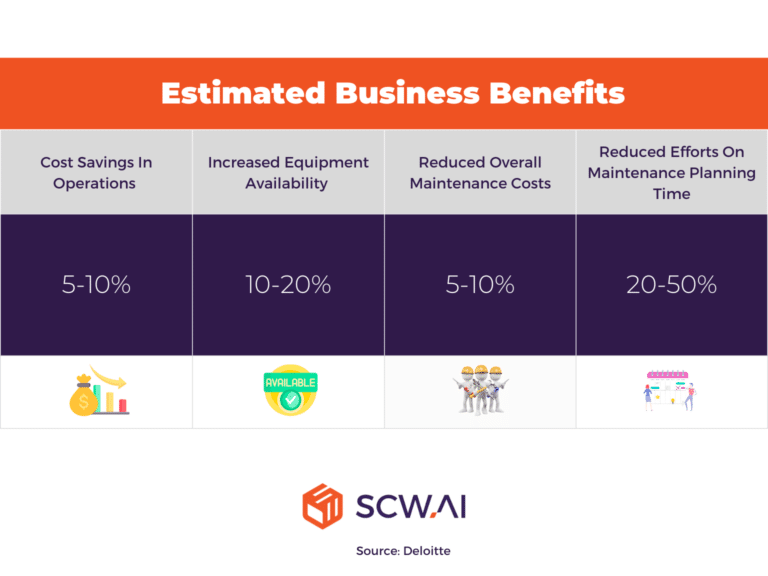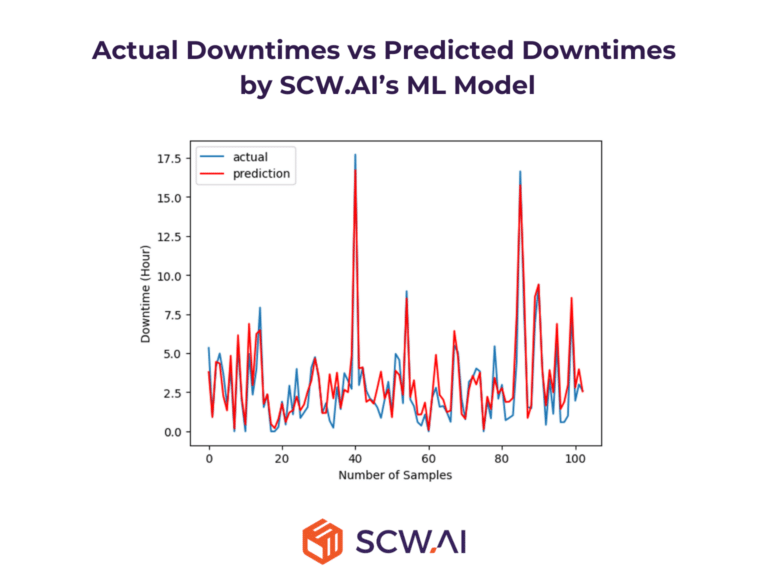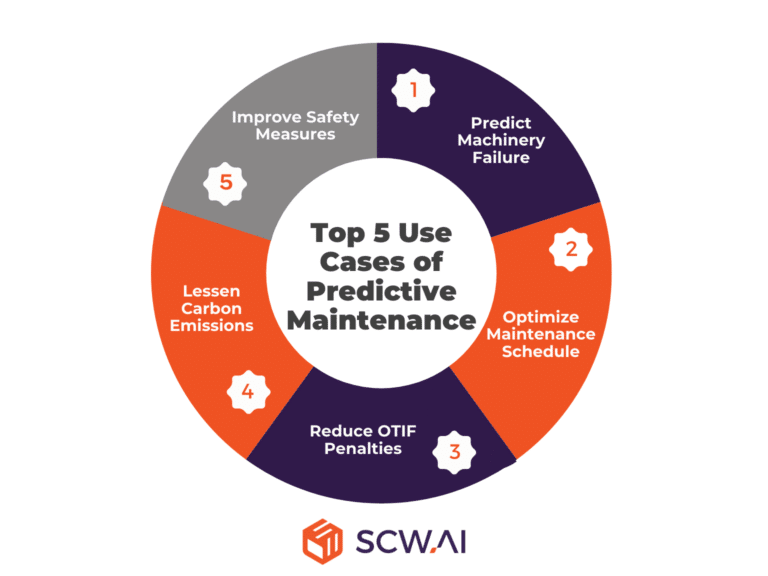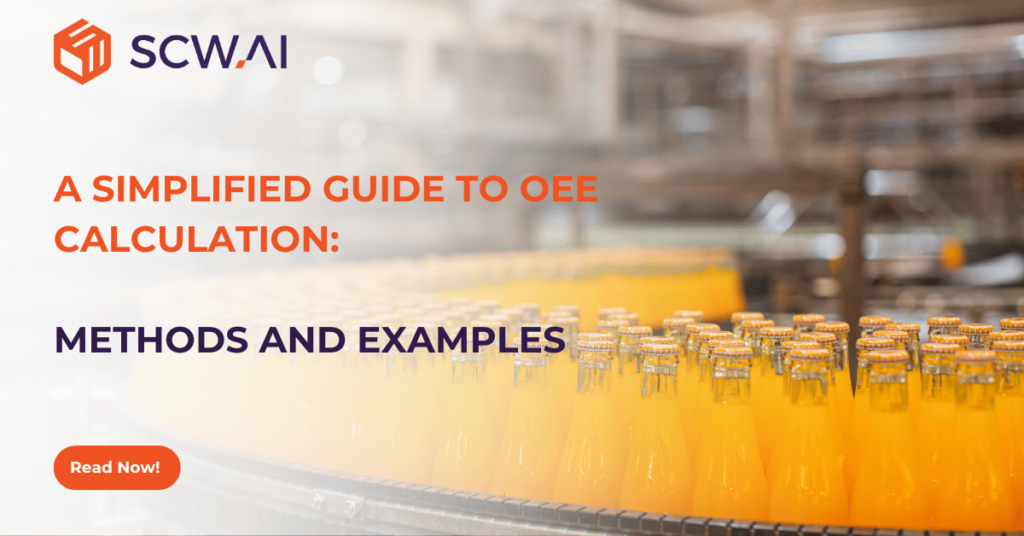
For manufacturers, machinery failure leads to costly downtime, production delays and increased costs of goods sold. This can negatively impact production efficiency, lead to On-Time & In-Full (OTIF) penalties, and strained customer relations.
Predictive maintenance with machine learning emerges as a viable solution to mitigate the impact of unexpected machine failures. According to Deloitte, AI-driven anomaly detection and fault prediction in predictive maintenance can yield substantial benefits, including:
- Increasing runtime between 10 to 20%.
- Reducing maintenance costs by up to 10%.
- Minimizing the time needed for maintenance scheduling by up to 50%.
This article serves as a comprehensive guide for manufacturing executives, covering everything they need to know about predictive maintenance—from the training of machine learning (ML) models to the future of predictive maintenance and its associated applications. In conclusion, we will highlight how SCW.AI can assist companies in implementing ML powered predictive maintenance.
What is Predictive Maintenance With Machine Learning?
AI-driven predictive maintenance involves real-time monitoring of machines and equipment. By employing advanced analytics and machine learning algorithms, it identifies potential machine malfunctions before they occur, optimizing asset performance and extending the lifespan of equipment.
It adopts a proactive maintenance approach, seeking to address equipment issues before they lead to downtime. The ML model analyzes factors correlated with machine failure, notifying maintenance personnel and executives in advance for proactive intervention while the machine is still operational. This sets it apart from reactive maintenance, which responds to repairs after a breakdown.
Predictive maintenance is also different from preventive maintenance, since preventive maintenance often relies on operator and supervisor experience to schedule maintenance activities. In contrast, predictive maintenance signifies a transition towards digitalization, leveraging the full potential of historical equipment data and AI capabilities to ensure that maintenance occurs precisely when needed. Thus, it is a digital total productive maintenance practice for manufacturers.
As an illustration, the image below depicts the data from SCW.AI’s ML model, showcasing predictions for downtimes to facilitate efficient maintenance scheduling.

Why Should Manufacturers Consider Investing in Predictive Maintenance?
According to McKinsey, machine failures typically contribute to about 15% of all downtimes for pharmaceutical manufacturers. However, our customer data also suggests that machine failures can constitute up to 25% of downtimes in the pharmaceutical industry (See image below). It is crucial to note that, for the pharmaceutical sector, changeovers are the primary cause of downtimes due to regulatory requirements mandating thorough line cleaning. In contrast, for other industries, equipment failures might account for more than 25% of downtimes.
Nevertheless, equipment failure is a significant factor in downtime and minimizing it is essential for improving overall equipment effectiveness (OEE) and throughput.

On the other hand, relying on maintenance without data and advanced analytics can increase maintenance costs, as it may result in unnecessary repairs and inefficiencies. Achieving the right balance between mitigating disruptive equipment failures and avoiding excessive maintenance costs necessitates the implementation of predictive maintenance through machine learning and historical data.
This underscores why Deloitte highlights that predictive maintenance has the potential to decrease maintenance costs by up to 10%, simultaneously boosting runtime by as much as 20%.
To find a cost effective way to reduce changeover time for your factory, you can check SCW.AI’s Changeover Analysis Report.
Training of Machine Learning Models for Predictive Maintenance
Developing ML models for predictive maintenance is a complex undertaking, involving the integration of enriched data, the selection of appropriate algorithms, and the utilization of technologies like IoT and PLC devices to streamline data gathering. Often, these tasks are beyond the capacity of manufacturers.
Hence, McKinsey emphasizes the importance of collaborating with the right technology vendors as a best practice to ensure successful implementation of ML-driven predictive maintenance. The cloud AI capabilities and expertise in data gathering of these companies play a pivotal role in ensuring the success of digital transformation initiatives.
Nevertheless, here are the main 3 tasks to consider to build ML models:
1. Data for Training
The efficacy of ML models is directly tied to the quantity and quality of the data. Precise ML models rely on the collection of large, accurate, real-time data, finely tuned to the specific granularity necessary for identifying correlations between events and equipment failure.
Data must be devoid of gaps, overlaps, and errors. Storing information in a central data lake makes it easily accessible for training ML models.
Following data can be useful to train predictive maintenance with machine learning:
- Mean time to failure measures the average amount of time a non-repairable asset operates before failure. This metric helps ML models assess the reliability of equipment.
- Mean time to repair measures the average amount of time it takes to repair a device. This KPI helps ML estimate unplanned downtime if the predictive maintenance does not occur.
- Mean time between failures is the average time between system breakdowns. It helps AI predict the life-span of the equipment.
- Production speed of machines indicates how fast machines are utilized during runtime. Most of the time overspeeding is correlated with more equipment breakdowns.
- Employee interactions with machines can be associated with the life span of the equipment. Some workers may willingly or unwillingly damage equipment.
- Types of products produced can be also correlated with machine failures and a potential input for training ML models.
2. Algorithms Behind Predictive Maintenance

Predictive maintenance relies on algorithms to forecast equipment failures. Here are common algorithms and techniques used:
- Regression Analysis: Identifies patterns and finds correlation between the given feature set and the equipment behavior to make better predictions.
- Classification Algorithms: Classifies equipment health based on sensor data, using decision trees, support vector machines, or random forests.
- Time Series Analysis: Utilizes techniques like autoregression to understand temporal patterns in sensor data.
- Neural Networks: Handles complex, high-dimensional data for nonlinear relationships.
3. Supportive Technologies for Predictive Maintenance
To obtain real-time data on equipment conditions, manual data entry is an option, but it is time-consuming for employees and prone to errors. Hence, predictive maintenance with ML is predominantly supported by the following technologies:
- IoT: Automates data gathering from smart devices and the environment by using sensors.
- Modbus PLC: Automates data gathering from industrial processes.
- OPC: Gathers data through standardized communication protocols, utilizing either the DCOM-based approach in OPC Classic or the platform-independent OPC UA. This facilitates seamless and real-time exchange of information between various industrial devices and software applications.
To learn more about how IoT helps companies collect data you can read our Industrial IoT: How to Collect Manufacturing Data article.
Top 5 Use Cases of AI-Driven Predictive Maintenance

1. Predict Machinery Failure
Predictive analytics can forecast machinery failures by analyzing historical data, real-time sensor inputs, and various operational parameters. This proactive identification enables organizations to address potential issues before they escalate, minimizing unplanned downtime and the associated costs. Predicting machinery failures allows for timely maintenance interventions, ensuring that equipment operates at peak efficiency while reducing the risk of breakdowns.
2. Optimize Maintenance Schedule
Traditional preventive maintenance often relies on fixed schedules, leading to unnecessary downtime and increased maintenance costs. AI-driven predictive maintenance optimizes maintenance schedules by tailoring them to the actual condition of equipment. Thus, manufacturers can maximize operational uptime and minimize disruptions.
3. Reduce OTIF Penalties
By preventing unexpected breakdowns and streamlining maintenance activities, businesses can meet delivery commitments consistently. This not only enhances customer satisfaction but also avoids financial penalties associated with delayed deliveries, ultimately improving the bottom line.
4. Lessen Carbon Emissions
AI-driven predictive maintenance contributes to reducing carbon emissions by optimizing equipment performance. By ensuring that machines operate at peak efficiency and minimizing unnecessary idling, organizations can achieve significant energy savings and decrease their product carbon footprint.
5. Improve Safety Measures
Predictive maintenance enhances workplace safety by identifying and addressing potential equipment malfunctions before they pose safety risks. Proactively addressing issues reduces the likelihood of accidents and ensures a safer working environment for employees.
For further details on AI applications in manufacturing, see our article on the Top 5 AI Use Cases in Manufacturing.
Future of Machine Predictive Maintenance with Machine Learning
As emphasized by McKinsey, the current utilization of predictive maintenance with ML remains relatively uncommon. Nevertheless, the increasing number of academic research publications on the subject indicates a growing enhancement of our theoretical capabilities.
In the short term, we anticipate a rise in the adoption of ML-driven predictive maintenance by more factories, aiming to enhance production efficiency and reduce costs. Similar to the adoption of any pivotal technology, SCW.AI anticipates that early adopters will gain a competitive advantage over their rivals, compelling the rest of the industry to follow suit in adopting predictive maintenance practices.
Check out our comprehensive guide on advanced planning and scheduling for manufacturers, to learn about another prominent application of AI in the shop floor.
How Can SCW.AI Improve Your Maintenance Practices?

SCW.AI offers customers a cloud-based Predictive Maintenance feature as part of the AI Hub. Furthermore, our Maintenance Performance Report delivers detailed data on mean time to failure, mean time to repair, and mean time between failures. Leveraging our Asset Tracker and IoT Hub capabilities, manufacturers can automate data gathering for ML-driven predictive maintenance.
To embark on shaping the future of manufacturing, book a demo with us today!


